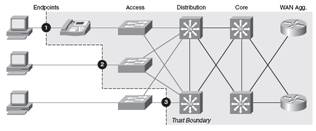QoS technologies ensure that latency- and jitter-intolerant applications, such as voice and video, will receive end-to-end priority service. Achieving end-to-end priority services requires QoS functionality from virtually every device in of the voice networks. Using quality of service (QoS) on Cisco network devices helps provide both bandwidth and priority to certain types of network traffic.
We can configure QoS features in the networks for end-to-end QoS delivery. The following three components are necessary to deliver QoS across a diverse network:
- QoS within a single network element, which includes queuing, scheduling, and traffic shaping features.
- QoS signaling techniques for coordinating QoS for end-to-end delivery between network elements.
- QoS policing and management functions to control and administer end-to-end traffic across a network.
All QoS techniques may not be suitable for all network routers. As edge routers and backbone routers in a network may perform different set of operations, the QoS tasks they are going to perform will also differ. To configure an IP network for real-time voice traffic, for example, we would need to consider the functions of both edge and backbone routers in the network, and then choose the right QoS feature and features.
Edge routers perform the following QoS functions:
- Packet classification
- Admission control
- Configuration management
Backbone routers usually perform the following QoS functions:
- Congestion management
- Congestion avoidance
Cisco has Auto QoS feature which facilitates applying various QoS mechanisms on network devices. Before the deployment of Auto QoS we need to establish trust boundary for voice networks. The trust boundary is the point in the network from where we begin trusting that network traffic is properly identified with correct QoS markings. We deploy QoS markings close to the user devices. Figure 1 illustrates the trust boundary in QoS.
Figure 1: Trust boundary in QoS

Cisco IP phones have the capability to mark their traffic as high priority and strip off any high-priority markings from traffic sent by the attached system. In the scenario where we are using Cisco IP phones, we have extended the trust boundary to point 1. In the case where PC is attached to the network with access layer switches with QoS capabilities, we mark devices (as shown in point 2). If the access layer switches don’t support QoS capabilities, then markings to be done at the distribution layer switches (point 3). To apply Auto QoS we need to identify places on the network where QoS will be applied. It does not need to be applied at all interfaces; it should be applied only to interfaces on which the devices/applications need preference over other traffic in the network. Now we will look at an example illustrating where to apply Auto QoS on access layer switch ports.
Voice_switch# config term
Voice_switch (config) # interface fa0/3
Voice_switch (config-if) #auto qos? (Voip configure AutoQoS for voip)
Voice_switch (config-if) #auto qos voip
Cisco-phone trust the QoS marking of cisco ip phone
Cisco-softphone trust the QoS marking of cisco IP softphone
Trust trust the DSCP/CoS marking
Voice_switch (config-if) #auto qos voip cisco-phone
Voice_switch (config-if) #^Z
Display running configuration
Show run interface fastethernet 0/3
Interface fastethernet0/3
Description CONNECTION TO IP PHONE
Switchport access vlan 10
Switchport mode access
Switchport voice vlan 5
Mls qos trust device cisco-phone
Mls qos trust cos
Auto qos voip cisco-phone
The command auto qos voip cisco-phone or auto qos voip cisco-softphone will only enable trust boundary if CDP detects IP phone or cisco IP communicator. If a device is removed from the port, the trust boundary is broken till device is reattached again. If you issue a command auto qos voip trust, then any device will be trusted, required in case you use non Cisco phones in voice network.
Now to enable Auto QoS on switch for the interface connecting to the router.
Voice_switch# config term
Voice_switch (config) # interface fa0/1
Voice_switch (config-if) #auto qos voip trust
Voice_switch (config-if) # ^Z
Display running configuration
Show run interface fastethernet 0/1
Interface fastethernet0/1
Description CONNECTION TO ROUTER
Switchport access vlan 10
Switchport mode access
Mls qos trust cos
Auto qos voip trust
The final step is to enable Auto QoS on the router’s fastethernet interface and serial interface with the syntax given below:
CME_voice# configure terminal
CME_voice(config)# interface fastethernet0/0
CME_voice(config-if)# auto ?
Discovery configure auto discovery
Qos configure AutoQoS
CME_voice(config-if)# auto qos voip trust
CME_voice(config-if)# exit
CME_voice(config-if)# interface serial 0/0
CME_voice(config-if)# auto qos voip trust
CME_voice(config-if)#^Z
This concluded the CCNA Voice lesson on where to deploy QoS on voice networks. We learned about QoS in general in past few sections, this section primarily focused on where to configure QoS, and how. We also looked at the Auto QoS feature of Cisco IOS which makes deployment of QoS very simpler in voice networks.
